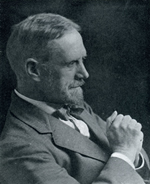Samuel Clegg was the son of Alexander Clegg, who came to Sawley in 1882 to take up the position of master of the Baptist School.
In 1884 (aged 13) Samuel started as a pupil-teacher in the Baptist School, before doing another two years at Radford. He then went on to acquire a teacher’s certificate at Owens College, Manchester (later Manchester University) followed by two years teaching in Derby, before becoming a teacher in Long Eaton.
By 1897 he was in charge of the Long Eaton Pupil Teachers’ Centre. Under his leadership this gradually expanded. When Derbyshire County Council decided to establish a secondary school in Long Eaton they commissioned Professor Michael Sadler to produce a feasibility study.
Sadler was impressed by the flourishing Pupil Teacher Centre and by Samuel Clegg, and he recommended that they be the basis of the new school. The Long Eaton County School and Pupil Teacher Centre was opened in 1910, and Clegg served as its headmaster until his death in 1930. From 1945 it was known as Long Eaton Grammar School.
He was also secretary of the committee which established a public library in Long Eaton, a leading member of the local Liberal Association, and of the Long Eaton Co-operative Society, taking classes in ‘The Principles of Co-operation’, and producing the first history of the society in 1901.
In 1897 he designed and had built ‘Rye Hill Close’ 194 Tamworth Nottingham Road. In 1908 he organised a matching house at 196 Tamworth Road, which became the home of Dr Charles Hugh Latham.
Samuel Clegg’s daughter Mary attended the County School where her friends included Arthur Kingscott’s younger son Cecil. She later married Frederick Attenborough, who had once been a teacher at the school. Their children include the late (Lord) Richard Attenborough, the actor and film director and Sir David Attenborough, the TV producer and presenter. Samuel Clegg’s son became Sir Alec Clegg, one of the country’s most important educationalists, whose son Peter became a leading architect.

